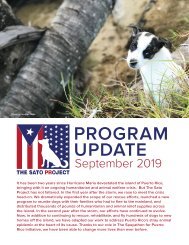Celebrating 10 Years of The Sato Project
When The Sato Project was founded in 2011, our work began by rescuing one dog at a time from Dead Dog Beach. 10 Years later we have flown and vetted over 6,000 dogs from the streets and beaches of Puerto Rico to loving homes on the mainland. We have also spay/neutered and vaccinated over 7,500 animals and distributed 136K lbs of disaster relief supplies across the island in the wake of Puerto Rico's multiple natural disasters. None of these accomplishments would have been possible without the support of our #satostrong community. Read this special edition 10th Anniversary Program Report for The Sato Project's full story.
When The Sato Project was founded in 2011, our work began by rescuing one dog at a time from Dead Dog Beach. 10 Years later we have flown and vetted over 6,000 dogs from the streets and beaches of Puerto Rico to loving homes on the mainland. We have also spay/neutered and vaccinated over 7,500 animals and distributed 136K lbs of disaster relief supplies across the island in the wake of Puerto Rico's multiple natural disasters. None of these accomplishments would have been possible without the support of our #satostrong community. Read this special edition 10th Anniversary Program Report for The Sato Project's full story.
Create successful ePaper yourself
Turn your PDF publications into a flip-book with our unique Google optimized e-Paper software.
THE STORM LEFT A HUMANITARIAN
CRISIS THAT CONTINUES TODAY
The number of abandoned and stray dogs roaming
the island skyrocketed after Hurricane Maria.
Immediately after the storm, there was an exodus of
residents who fled Puerto Rico for the mainland. Many
residents who remained on the island struggled to survive
and could no longer afford to care for their pets. Both
circumstances led to even more dogs being abandoned,
surrendered, neglected, and left behind. This created a
huge snowball effect.
Many of these abandoned dogs were not spayed or
neutered, which led to a dramatic increase in the number of
unwanted litters being born in the streets. The stray animal
population grew higher and higher, and The Sato Project’s
email addresses and social media accounts became
flooded with people asking for help with stray dogs. After
six years of hard work and advocacy, Dead Dog Beach had
mostly been cleared of stray dogs. However, we started
seeing more dogs show up, newly abandoned. On multiple
occasions we found entire boxes of puppies abandoned on
the front steps of our veterinary clinic or on the side of the
road. The few programs providing spay/neuter and vaccine
services that existed before the hurricanes were all shut
down for many months as well.
Before Hurricane Maria, official data estimated the
number of stray dogs on the island to be around
300,000. By the one year anniversary of the storm,
that number had risen to 500,000.
We also saw an increase in deadly diseases such as
heartworm, ehrlichia, parvovirus, and leptospirosis
among the dogs we were rescuing. Leptospirosis is
zoonotic (transmissible to humans) and can even be
deadly. In addition to this, we routinely rescued extremely
malnourished dogs in need of emergency veterinary care,
as well as entire families of female dogs with their puppies.
8
Dogs with serious orthopedic issues after being hit by
vehicles or hurt in the hurricane also became a new normal.
We estimate that we lost approximately 10 years of work
due to the devastation of Hurricane Maria. It would have
been easy to feel hopeless in such dire circumstances.
However, our incredible community of donors, adopters,
and volunteers immediately came to our aid. We will never
forget how much our community showed up for us in
Hurricane Maria’s aftermath. This support allowed us
to dramatically increase our operations to meet the new
demand and logistical challenges of an island in perpetual
recovery mode.
Pre-Hurricane Maria, we rescued roughly 350 dogs per
year. In the first year after Hurricane Maria, we rescued
and transported 1,500 dogs. Additionally, we dramatically
expanded our community outreach efforts to help pet
owners and other organizations in need. In 2018, we
distributed over 69,000 pounds of humanitarian and animal
emergency relief supplies. Thanks to our partnership with
Spayathon for Puerto Rico and our spay/neuter community
voucher program, we were able to spay/neuter and
vaccinate over 2,400 dogs and cats that year as well.
Hurricane Maria also led to the creation of our ‘No Dog
Left Behind’ program. During the first few months after
the storm, some estimates suggest that as many as 10,000
people were leaving Puerto Rico each week. Unable to find
or afford passage for their pets, some families anxiously left
their pets behind in the care of neighbors or friends, unsure
of when they would see them again. No Dog Left Behind
was created to reunite these families with their pets on
the mainland. In the first year of this program, we reunited
nearly 200 dogs with their families.
All of these programs that were started in the aftermath
of Hurricane Maria today remain a permanent part of our
rescue operations.





